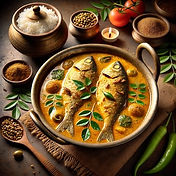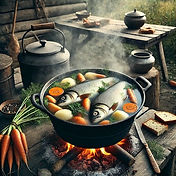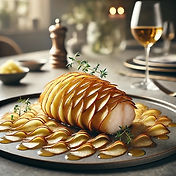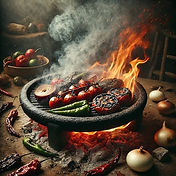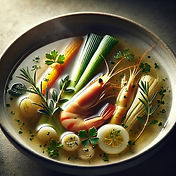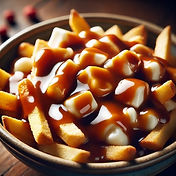Top Chef ™: Wisconsin
Season:
Week:
Elimination Challenge

The chefs were randomly assigned one of thirteen different cheeses. They were then asked to make dishes featuring their designated cheeses for a Top Chef cheese festival. The dishes were served to the judging panel and one hundred festival guests. The guests' votes determined the top dishes and winner of the challenge, while the judges selected the bottom dishes. The winner received immunity for the next Elimination Challenge. The guest judges were Carla Hall and chef Dane Baldwin.
Kristen Kish: "All right, chefs, for your elimination challenge, you will each be responsible for creating one dish featuring one of these incredible cheeses. Carla and I will join Tom and Gail, along with local chef and James Beard award winner Dane Baldwin and 100 cheese loving diners."
Note - 50% of the chefs decided to cook some version of a cheese croquette. In her affiliated TV show, "A Dish with Kish ™", Kristen Kish dedicated an episode to the Cheese Croquette. See our recipe and her commentary here.

Get recipes ...
Subscribe to our weekly recipes and culinary tips from streamed cooking shows.
Dishes prepared in
Top Chef ™: Wisconsin
Chef Charly: "I've got yuca (cassava) boiling in here. I'm going to make some yuca croquettes. It's going to be good. When I'm thinking about how to serve 100 people, well, croquette's pretty easy and awesome because you fry them, which means that every few minutes, people are getting fresh croquettes."
Chef Charly (presenting to judges): "So I made these yuca croquettes filled with the canela cheese. And then we have a tomato mango sauce on the side. Canela has a honey note to it that I think works really well with the fruitiness of the mango and the tomato sauce."
Chef Manny: " lived in ten different cities, but I have never lived in the midwest. I only know two dishes with cheese curds, poutine, and fried cheese curds. So I go with poutine with a potato croquette, cheese curds, and scallions. Good old pork fat."
Chef Manny (during prep): "I'm going to put the cheese on top. I don't want the croquettes to be gooey. I want to be able to fry them without them falling apart. I'm going to press them in between two sheet trays, and I'm going to let them cool down overnight, and cut them tomorrow, bread them, and fry them."
Chef Manny (presenting to judges): "We have a potato croquette, cheese curds, and beer gravy.
Kirsten Kish: "So there's no cheese curd in the potato?"
Chef Manny: "No, there's no cheese curd in the potatoes. Instead of having french fries with curds and gravy, I'm having potato croquette.
Chef Alisha: "I'm going to do a traditional spanish croquette with some smoked pork."
Chef Alisha (during prep): "I got brick cheese. So I'm doing a play on a ham and cheese sandwich."
Tom Colicchio: "When was the last time you made a croquette?"
Chef Alisha: "I make them all the time. I feel pretty confident in this dish. I mean, my cuisine is spanish food."
Tom Colicchio (laughing): "Okay, so you're making coquetto. okay."
Chef Alisha: "My culinary style is definitely inspired by coastal spanish food, but I live in the midwest. Nowhere near an ocean. Of course, the first time I feel like I can really represent myself, everyone else is doing the same thing."
Chef Alisha (presenting to judges): "The rind of this lovely cheese is actually washed in Merlot. My dish is ham and brick cheese croquettes with a sherry aioli."
Chef Kaleena: "I pulled a merlot bellavatano. It seems like it's going to have that beautiful melt that a cheddar does, but it has a much bolder, complex flavor. I feel like I got the best of both worlds with this cheese."
Chef Kaleena (during prep): "Don't judge my store-bought pasta, please. I'm cooking for 100 people. This is not the challenge where you're going to make a pasta from scratch. This is the challenge where you're going to highlight the cheese and get the job done. Not so much Mac and cheese. More like a play on Alfredo."
Chef Kaleena: (presenting to judges): "I thought everyone was going to be doing macaroni and cheeses, and then somehow I'm the only one. I used the BellaVitano in it. I wanted to bring out the flavors of the rind of the cheese, so I braised some mushrooms and some aromatics and merlot."
Chef Amanda: "I'm making some raclette aroncini. There's Mornay inside the aroncini, and then on the bottom is a Mornay and Dijon sauce and a little bit of fig and olive."
Chef Kevin: "So you have a sauce mornay with diced ham, chives, and on the top, you have a truffle paste made with mushroom and truffle."
Kristen Kish: "What was the breading? Just three step breading?"
Chef Kevin: "Yeah."
Tom Colicchio: "Why did you want to make a croquette with the cheese?"
Chef Kevin: :"Because for me it's the creaminess of the cheese. I just wanted to make melted croquette with truffle."
Chef Savannah (presenting to judges): "When I got Oaxaca cheese, my first thought was quesadilla, so I just kind of leaned straight into that. I have a white hominy tortilla made from scratch and cooked to order with a whipped avocado and hatch chili."
Chef Laura: "I picked Gouda. It's amazing. It's very nutty. Lots of crystals in it, so it's delicious. And I think it's perfect with the croquettes."
Chef Laura (presenting to judges): "I picked this beautiful Gouda Reserve that's been aged. I'm using the idea of a moustarda potato."
Chef Rasika: "I got the Dunbarton Bleu, and it's not a traditional blue cheese. It has more cheddar notes in it, and it's nutty. The first nut that popped into my head is hazelnut."
Chef Rasika: "I grabbed chicken thighs for cheese and rice cakes with a chicken gravy. There's a South Indian rice cake called paniyaram. Basically, it's a fermented rice batter. This batter takes two days for fermentation, but I'm trying to push it for 2 hours."
Chef Rasika (presenting to judges): "I had the Dunbarton bleu cheese. It's a cheddar blue. So I did rice cake. It's called a panyarum. I folded the cheese in the batter of the rice cake. I made a braised chicken thigh korma."
Chef Danny (presenting to judges): "I made Cheddar fritter with a cheddar lime mornay, and then the outside is a cheddar lime foam. I just try to highlight the cheese as best I could."
Kristen Kish: "Pâte a Choux and then cheddar inside?"
Chef Danny: "Exactly."
Chef Dan (presenting to the judges): "I was lucky enough to get a cheese from Door County, Wisconsin. It's Sancho Cruz, Manchego. I'm doing this with some potato dumplings. I've aerated the cheese and olive and charred scallion sauce, and then finish it off with some fried potatoes."
Chef Kenny: "I've got a little ponzu going with my crab. It's going to be a little crab salad. We're going to be serving in 100 degrees, so instead of doing another deep fried option with everyone else, I'm going to flip this crab rangoon on its head and make a salad with it."
"Normally, I use cream cheese, but this really creamy gorgonzola is going to go really well with this sweet crab."
Tom Colicchio: "Hey, Kenny, what are you working on there?"
Chef Kenny (during prep): "Light little maraschino cherry relish to go with my gorgonzola crab rangoon."
Tom Colicchio: "So what are you doing with the gorgonzola?"
Kenny: "I have made a creme out of it and made a little crab salad. I grew up eating crab rangoons, so gorgonzola feels a little more familiar to me."
Chef Kenny (presenting to judges): "Today I prepared a crab rangoon salad with a gorgonzola creme fraiche crema, little luxardo cherry relish, and chili hibiscus flake on a rice paper chip."
Chef Michelle: "I'm going to do a play on sag paneer. Kind of a coconut curry. Collard greens. I do not cook a lot of indian food. I do cook a lot of southern food. Sag paneer typically uses paneer cheese and spinach. I've decided to go with collard greens. It really just speaks to who I am. "
Chef Michelle (presenting to the judges): "I picked Pleasant Ridge reserve cheese today, and I did a take on a sag paneer for the coconut curry gravy. I have collard greens in there. The fritter is made of potato, more cheese, a little bit of curry, and cilantro."
Culinary Challenges inspired by
Top Chef ™: Wisconsin
Meen Moilee is a celebrated Kerala fish curry that exemplifies South Indian coastal cuisine. This luxurious dish features firm white fish gently poached in a velvety coconut milk sauce infused with aromatic spices. The preparation begins by sautéing curry leaves, green chilies, ginger, and onions until fragrant, then adding turmeric, ground spices, and coconut milk to create a golden, creamy base. The fish is carefully added last, allowing it to cook just until tender. The hallmark of Meen Moilee is its balanced flavor profile - mild heat complemented by tanginess from tomatoes or sometimes vinegar, sweetness from coconut milk, and brightness from fresh lime juice. Served with rice, this curry represents the perfect harmony of Kerala's abundant seafood and tropical ingredients.
Ukha is a traditional Russian clear fish broth that dates back centuries, revered for its clean, delicate flavors. This aromatic soup begins by gently simmering whole fish—typically freshwater varieties like pike, perch, or sturgeon—with minimal vegetables and aromatics, allowing the pure essence of the fish to shine through.
The preparation is deliberately simple: fish, onions, carrots, bay leaves, black peppercorns, and occasionally potatoes or leeks. What distinguishes ukha is its clarity—the broth should remain transparent, never cloudy. Often finished with fresh herbs like dill or parsley and a splash of vodka, authentic ukha embodies Russian cuisine's philosophy of highlighting natural flavors rather than masking them with excessive seasonings.
Pommes de terre en écailles, meaning "scaly potatoes" in French, is an elegant potato preparation technique that transforms the humble tuber into a sophisticated side dish. Thin-sliced rounds of peeled potatoes are meticulously arranged in overlapping patterns resembling fish scales or roof tiles in a buttered dish. Each layer is brushed with melted butter and seasoned with salt and pepper before the next is added. The assembled potatoes are then baked until the edges turn wonderfully crisp while the centers remain tender.
The result is a visually striking dish with beautiful textural contrast—crispy, golden exterior scales protecting creamy interiors—that elevates any meal with its refined presentation and rich buttery flavor.
Dawadawa is a traditional West African fermented seasoning made primarily from locust beans (Parkia biglobosa), though occasionally from soybeans or other legumes. The preparation begins by boiling the beans until soft, then pounding them to remove the seed coats. The cleaned seeds are boiled again, spread out, and covered with leaves to ferment naturally for 2-3 days. This fermentation process develops a pungent aroma and complex, umami-rich flavor profile. The resulting black paste is typically shaped into balls or patties for storage. Used as a flavor foundation in soups, stews, and sauces across Ghana, Nigeria, and other West African countries, dawadawa adds remarkable depth and nutritional value to countless dishes.
You can buy dawadawa spice here.
Pipian is a rich, traditional Mexican sauce that exemplifies the complexity of pre-Hispanic cuisine. Made from ground pumpkin or squash seeds (pepitas), this velvety sauce incorporates various chiles, spices, and sometimes nuts or seeds like sesame or peanuts. The ingredients are toasted, ground into a paste, and simmered with broth until thickened to a smooth consistency. Pipian can range from vibrant green (pipian verde) to deep red (pipian rojo), depending on the chiles used. Commonly served over poultry or pork, this sauce offers a nutty, earthy flavor profile with subtle heat that showcases Mexico's remarkable ability to balance complex flavors into harmonious dishes.
Tatemado is a traditional Mexican cooking technique most commonly associated with Jalisco cuisine. This slow-cooking method involves placing ingredients—typically meat such as pork, goat, or beef—into clay pots that are partially buried in hot coals or placed in an underground pit oven. The pots are sealed with masa (corn dough) to trap moisture and smoke, allowing the meat to cook gently for several hours until incredibly tender. This process imparts a distinctive earthy flavor while preserving the meat's natural juices.
Tatemado dishes are often seasoned with regional spices, chiles, and herbs, creating complex flavor profiles that showcase Mexico's rich culinary heritage. The result is meltingly tender meat with unparalleled depth of flavor.
Nage, pronounced "nahj," is a fragrant, aromatic broth used in French cuisine primarily for poaching seafood and vegetables. This delicate liquid is typically created by simmering wine, water, or fish stock with aromatic vegetables (onions, celery, fennel) and herbs. After cooking, the ingredients may be strained out, and the remaining liquid can be reduced and enriched with butter to create a "beurre monté" sauce.
The term 'nage' is also used to describe dishes cooked in this liquid—referred to as "à la nage"—resulting in light, flavorful preparations that highlight the natural taste of the main ingredient while infusing it with subtle complexity.
Poutine: Quebec's Beloved Comfort Food
Poutine is a Canadian culinary treasure originating from Quebec in the late 1950s. This hearty dish consists of three essential components: crispy french fries, cheese curds, and rich brown gravy poured generously over the top, creating a delicious mess of contrasting textures and flavors.
The magic of poutine lies in its seemingly simple yet perfectly balanced combination. When done right, the fries remain crisp on the outside while soaking up savory gravy. The cheese curds, which must be fresh to achieve their signature 'squeak' between your teeth, soften slightly from the heat without fully melting. The gravy ties everything together with its savory depth. It is basically a roux, traditionally thickened with chicken or beef stock but a vegetarian option is just as good, with flavor from umami-rich mushrooms or earthy beets.
To create authentic poutine at home, begin with freshly cut potatoes, twice-fried for optimal crispness - first at a lower temperature to cook through, then at a higher temperature for that golden exterior. The cheese curds should be room temperature and as fresh as possible. Their slightly tangy flavor and distinctive texture cannot be substituted with shredded cheese. For the gravy, create a flavorful stock reduction, thickened to a consistency that coats the back of a spoon without being gloopy.
Assembly requires careful timing. The fries must be piping hot from the fryer, immediately topped with curds and quickly covered with steaming gravy that's hot enough to warm the curds but not so hot it melts them completely.
While traditional poutine remains a beloved classic, modern variations might include toppings like pulled pork, smoked meat, or even lobster. Whether enjoyed from a roadside stand in rural Quebec or prepared in your kitchen, poutine represents comfort food at its finest. it is unpretentious, indulgent, and deeply satisfying.
Soba Cha (also known as Soba-Cha and Sobacha) is Japanese buckwheat tea. It is drunk hot or cold, and is gluten-free and caffeine-free and apparently tastes nutty and slightly sweet.
It appeared three times in Top Chef: Wisconsin ™. The first showing was in Restaurant Wars when Danny's team, under his leadership, served up cold Soba Cha as a welcome drink. It wasn't well received.
In reparation, Danny re-introduced it in week 12 when he infused mushrooms into Soba Cha for his fish dish. This time, the judges regretted that he had buried the flavor of the buckwheat tea in very powerful mushroom flavors and would have preferred the essence of the tea to shine through.
Danny didn't try again, but Dan used Soba Cha in his Smoked Dashi and this time it went down a storm.
Hummingbird cake is a Jamaican banana and pineapple spiced cake which has been eaten in the southern United States since the 1970s. It is a leavened cake with a salty cake and often contains pecans.
Mofongo is a Caribbean dish originating in Puerto Rico and the Dominican Republic. Made by mashing ripe plantains with fat, garlic, spices, and (optionally) pork crackling, it is then shaped into a ball. The dish is famous for its complex and contrasting textures, with fried plantains that are crispy on the outside and soft on the inside. It is often found topped with melted cheese and served with a clear garlic broth.
Danny, in the 'spoiler' for the Top Chef Wisconsin Finale, was heard to say that he wanted to get fresh scallops for his first course and treat them in the style of "Leche de Tigre".
Leche de tigre, (translates to tiger's milk), is the Peruvian term for a citrus marinade that cures fish or seafood. Also known as leche de pantera, this marinade usually contains lime juice, onion, chile, and fish sauce.














